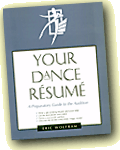|
Wolfram |
| Search |
 A Guide to the Audition
A Guide to the Audition
By Eric WolframIn the memory of Peter Iaria Dancers don’t like to read. They respond to images of beauty, not to words; and I’m not going to argue that point because the proof is in the bookstores. The dance section, if there is one, is a shelf half-filled with books that never made the New York Times best-seller list. The few exceptions are the books written by celebrities, which appeal to the non-dancing public – people who like to read stories about the twisted lives of dancers on their graves, or the biographies of choreographic geniuses like Mark Morris. The dance books sold to actual dancers are filled with pictures, not words. Dancers don’t write much either. In twelve years of professional experience, I never met a dancer who was asked to write anything. Furthermore, dancers start young. Their adolescent focus is on training and rehearsals which end at 10:30 p.m.; not on grammar teachers who, bless their souls, tend to ramble on about predicates and indirect objects. Dancers ignore writing and words. This truism would be laughable if it were not so serious. So how is a dancer supposed to write a good résumé. We used the following method. The day before an audition, we’d ask someone to borrow their résumé, and then we’d copy it. The result depended on the quality of the résumé we copied. Others would have their fathers, who never seem understand that heights and weights are important to an artistic director, write their résumés. The results tend to be corporate forms, highlighting college training (a big no-no) and instead of the most important roles that the dancers performed. I knew there had to be a better way. So where does a dancer go when it comes time to audition? My answer is here, or to a copy of a book called Your Dance Resume, which contains fine sample résumés. I hope that this will help dancers who don’t have another dancer’s résumé to borrow. Text from my book on the web for free. My brother pointed out that the circle of people who dance and the circle of people with computer rarely meet, which at the time, was another unfortunate truism. So why did I publish my book on the web anyway? Because I felt like it, that’s why.
|
Table of ContentsI- AcknowledgmentsAll the wonderful people who helped me along the way. II- About the Author Who am I?
|